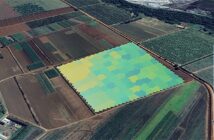Tackling the commonest trace element deficiency in UK arable crops has been made easier and more effective with the launch of a new concentrated manganese formulation requiring lower application rates than common alternatives.
Mn350, available from Fielder (UK) Ltd, includes 35% manganese in both nitrate and sulphate formats, plus significant inclusions of potassium (6.5%), nitrogen (10%) and sulphur (11%) to provide additional crop nutrition benefits.
Manganese deficiency is common across many soil types and exacerbated by wet and cold conditions, affecting cereals, oilseed rape, legumes and many other crop types. It is estimated to have some impact in 60-70% of UK soils, and is most commonly seen in cereal crops, appearing as light brown stripes of dying tissue on otherwise green leaves.
“If signs of manganese deficiency are visible then the crop will already be at risk of a yield deficit down the line,” explains Barrie Hawkin of Fielder. “It’s important to be vigilant and act quickly by applying manganese, particularly when crops are under stress due to cold and wet conditions, or when crops are in water deficit. Manganese deficiency is quite commonly seen, but few appreciate the impact it can have on the yield potential of crops come harvest.”
Mn350 offers a more concentrated form of manganese (35% compared with the 15% most commonly available) and contains both nitrate and sulphate salts. This makes the manganese readily available, for rapid plant uptake, but also ensures a good level of persistence in the leaf. Given its more concentrated formulation, Mn350 requires lower application rates than conventional forms of manganese, at 0.5–1.5l/ha, so is quicker and easier to apply as a stand-alone application, or takes up less tank capacity when applied in a tank mix with fungicides or herbicides.
“There is also the practical consideration of storage before use and disposal of spent containers,” adds Barrie Hawkin. “Mn350 is supplied in 5 litre containers, which are easier to store, handle and dispose of than the 1,000 litre bulk containers used for most conventional manganese products.”




